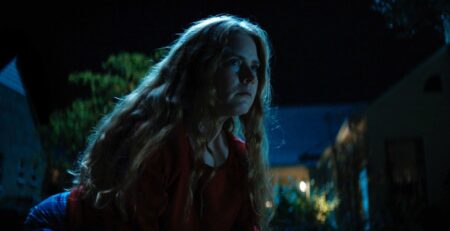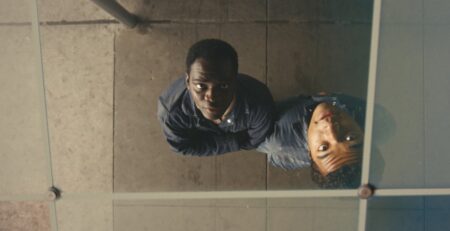
Cocoon (2023) is a queer German-language coming-of-age film written and directed by Leonie Krippendorff about the blazing heat of Berlin summer and one teenager who emerges from her chrysalis during it.
It’s so hard to be a kid. There are so many pressures, more and more so these days. Nora (Lena Urzendowsky) finds herself following around her older sister Jule (Lena Klenke) and her best friend Aylin (Elina Vildanova) most days, listening to their unhealthy relationships with food and their bodies, dealing with their vulgar friends vying for attention and frocking for all of their female friends. Cocoon opens on such a day. It doesn’t end well. And you’re shocked to learn all you do about Jule and Nora’s relationship in these opening scenes. They set a slow tone that isn’t in any kind of rush to arrive anywhere in particular while clearly establishing the deary world they inhabit with a narrow aspect ratio and a slightly yellow color grading awash in poverty and neglect.
When Nora meets Romy (Jella Haase), her body knows how she feels more quickly than her mind does. She’s never had much help in the way of understanding attraction and when she tries to explain, she only gets shut down. Rather than a movie about a kid struggling to understand though, Cocoon (2023) allows Nora to simply explore her feelings untethered from the judgment of her sister or anybody else. And slowly, subtly, like the caterpillars Nora keeps in her bedroom, Nora’s worldview and her sense of self evolve and broaden in a sequence of ethereally shot scenes, basked in light and love and soft music. All the things that are missing from Nora’s life at home. There are other changes to the visual presentation of the movie that are so incremental I hardly noticed and had to rewind to even find where it all began and how long it took to finish changing.
I’m a bit perturbed by the fact that these characters who are all meant to be teenagers appear naked on-screen many times over. The actors are all substantially older than their characters, and my non-European sensibilities may just be attuned differently than the home audience’s but it certainly took me out of things every time it happened. On the other hand, the movie does not for a moment shy away from the reality of having a body, depicting periods, masturbation, and bodily injury in stark reality without every shying away, which all does set a tone for the movie and how it’s meant to be taken as a serious adult movie more than a YA-style story. I think the tone works overall, especially given some of the other themes besides just coming out, but I still can’t help but be a bit put off by the way it makes sexualize teenage bodies.
On a totally different note, while Cocoon is a queer coming out story first and foremost, and there’s no part of the movie more important than that, something that is bound to be overlooked and deserves a moment is the relationship between Nora and Jule—how it is shaped by their mother’s neglect, and the way that Jule’s quest to get with a certain boy throughout the movie serves to juxtapose Nora’s. Jule isn’t just a tool for making Nora more sympathetic.
She’s a character with depth all her own who is just as restricted by the social expectations and neglect of her mother as Nora is, only, Jule doesn’t have queerness to lean into to find her metamorphosis the way her sister does. In Jule, in her body image challenges and her seeking out boys who aren’t worth her time, and more, we see a different but also valuable picture of the harm of compulsory heterosexuality as it holds her back from being truly happy.
Overall, Cocoon (2023) is a very artistic and pretty to look at queer coming-of-age story. Its secondary plots and relationships as well as the very slow pace add a layer of realism to the whole affair that makes the ethereal depiction of Nora and Romy’s romance that much more interesting, even if on its own it honestly isn’t very. Coming out, even if just to yourself, is just a sliver of a person’s whole life, and while it’s the catalyst for Nora’s transformation as poetically paralleled in the caterpillars she takes care of, I appreciate that it’s a centerpiece surrounded by other interesting and in-depth pieces of her story as a whole too.
Cocoon (2023) is available now on video on demand.
Cocoon
-
Rating - 8/108/10
TL;DR
Overall, Cocoon is a very artistic and pretty to look at queer coming-of-age story. It’s secondary plots and relationships as well as the very slow pace add a layer of realism to the whole affair that makes the ethereal depiction of Nora and Romy’s romance that much more interesting, even if on its own it honestly isn’t very. Coming out, even if just to yourself, is just a sliver of a person’s whole life, and while it’s the catalyst for Nora’s transformation as poetically paralleled in the caterpillars she takes care of, I appreciate that it’s a centerpiece surrounded by other interesting and in-depth pieces of her story as a whole too.




